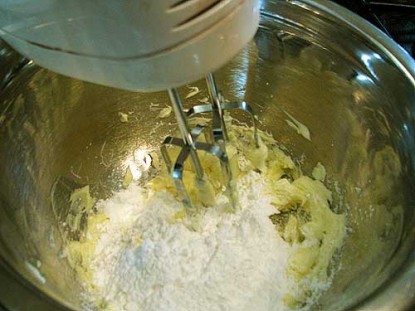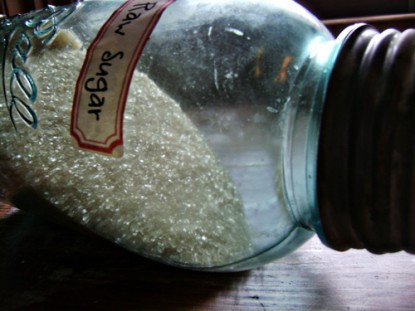2. A place in which food is cooked; a kitchen.


Sugar is a carbohydrate that occurs naturally in every fruit and vegetable through photosynthesis (process of converting light energy to chemical energy and storing it in the bonds of sugar) and through different processes, commercial sugar is derived–mainly from sugar cane and sugar beets. Unless our diet dictates, sugar is used in a majority of the foods we eat. Though there are many substitutes for sugars in eating, cooking, and baking, I’m talking about commercial sugar here.

What does sugar do for baking?
Sugar used in baking not only adds sweetness, but also affects the volume, tenderness, texture, color, and acts as a preservative.
Why does a recipe tell you to cream the butter with the sugar?
To get air into the batter. The sugar rubs against the fat making air bubbles. Then when the leaven is added, it causes the air bubbles to become larger and makes the batter rise when baked. The amount of time you cream the butter with the sugar determines the amount of air in the batter.
Sugar also attracts moisture in the batter which reduces the amount of gluten formed in the flour making a lighter, more tender crumb. Because of the moisture, the shelf-life of our baked goods is also longer.
Sugar is also the culprit of why your baked goods brown. The reaction of sugar and protein (milk and eggs) when heated causes the cookies, breads, and cakes to brown in the oven.
Two of the most important factors of sugar in baking/cooking: 1) The larger the size of the sugar crystal, the more air will be incorporated into the batter during the creaming of the sugar and fat. 2) The smaller the size of the sugar crystal, the faster it will dissolve into the batter.
The average American consumes nearly forty-three pounds of sugar per year in its many forms. While there are many more forms of sugar, I’ve come up with what I think is the most common and popular forms, their characteristics and what they’re used for to help you determine how you could substitute a different form of sugar when you’re cooking and baking or duplicating a favorite store-bought food.

White Sugars are made from both sugar cane and sugar beets. Through different processes, we are able to use different types of white sugars for different types of cooking, baking, and eating.
- Granulated Sugar, also called table sugar or white sugar, is the sugar most known and used white sugar. It’s found in your sugar bowl and the most frequently type of sugar called for in recipes. It is white-white in color (from processing) and is a fine crystal grain.
- Confectioners or Powdered Sugar, also known as Icing Sugar in Britain and Sucre Glace in France, is granulated sugar ground to a smooth powder and then sifted. It contains about 3% cornstarch to prevent caking. It is mostly used in icings and frostings.
- A substitute for powdered sugar: Mix 1 cup granulated sugar + 1 tablespoon corn starch in blender until powdery, stirring often.
- Coarse Sugar has a larger grain size than regular granulated sugar. It tends not to change color or break down at high temperatures. This is important in making fondants, confections and liquors.
- Bakers Special Sugar has a grain size between standard granulated and superfine. It was made specifically for the commercial bakers because the fine granules create a fine crumb texture. It’s also used for sugaring doughnuts and cookies.
- Superfine Sugar, similar to UK castor sugar, is ideal for delicately textured cakes and meringues, and for sweetening fruits and cold drinks because it dissolves easily as it has the finest grain of all the types of granulated white sugar.
- A substitute for superfine sugar: process regular sugar in a food processor or blender for about a minute.


Brown Sugars come from both sugar cane and sugar beets and is made by adding molasses back into the refined white sugar. In the past, when brown sugar was made from sugar cane, molasses was left in the sugar, but now, brown sugar made from both sugar cane and sugar beets are made the same way. The difference between light and dark brown sugar is the amount of molasses added in. Light brown sugar is most commonly used in baking and making butterscotch, condiments and glazes. Dark brown sugar has a more rich, full flavor which makes it good gingerbread and baked beans. But it’s your preference which you use!
- A substitute for dark brown sugar: thoroughly mix 1 cup granulated sugar plus 2 tablespoons molasses.
- A substitute for light brown sugar: thoroughly mix 1 cup granulated sugar plus 1 tablespoon molasses.

Raw Sugars are processed from sugar cane, but minimally. They have a higher molasses content and a coarser grain than granulated sugar, giving it a rich, complex flavor. Raw sugar is most commonly used for sprinkling on fruit, or rolling cookies in, as it’s much more expensive than normal granulated sugar. It can be substituted cup-for-cup for white sugar in most recipes if you want to.

Photo by Suzanne McMinn, Maple-Rum Raisin Cookies
- Demerara Sugar is a dry, coarse-textured amber sugar that has a toffee-like flavor and is popular in England in tea, coffee, or on hot cereals.
- Muscovada Sugar, or barbados sugar, is a very dark brown sugar. It is slightly coarser and stickier than most brown sugars and is resistant to high temperatures. Muscovada sugar is most commonly used in baking recipes and making rum.
- Turbinado Sugar is the result of the first pressing of sugar cane. It is light brown in color and coarse grained, with a slight molasses flavor. You will find turbinado sugar on the shelf here as Sugar in the Raw.

Photo by Suzanne McMinn, Natural Sugars Left–Turbinado, Right–Demerara
What is the shelf life of sugar?
Sugar, if properly stored, has an indefinite shelf life.
How do you store the different sugars?

- Granulated Sugar–store in a covered container in a cool, dry area.
- Powdered Sugar–store in a cool, dry area. If it gets moist, it develops lumps. Because it has cornstarch in it, it tends to absorb strong odors, even through the package.
- Brown Sugar–store in an airtight container in a cool, moist (if available) location. Because of the moisture content in brown sugar, it must be kept moist or it will harden.
Brown sugar can be frozen to keep the moisture content intact; allow to thaw for 2-3 hours before using. If ice crystals form after long freezer storage, gently stir the sugar as soon as it thaws to prevent pockets of moisture from causing damage.
Place a “brown sugar saver” in your storage container to help keep the moisture intact to prevent hardening. A piece of terra-cotta that has been soaked in water, then buried in the brown sugar or a piece of bread are cheap easy ways to keep your brown sugar soft.
How to soften your brown sugar if it’s already a hard clump?
Oven method–(if you’re going to use it immediately, as it will harden back up again)–heat it in a 250-degree oven, watching carefully, until it is soft.
Microwave method–(if you’re going to use it immediately, as it will harden back up again)–place it in a microwave-safe container, cover loosely with a wet (but not dripping) white paper towel, set the microwave on high, and check every 30 seconds until it is soft.
Wet paper towel method–place a moistened paper towel (not dripping) over the open container and leave it for several hours.
Apple method–place a cut apple piece in the container overnight then remove the next day.
Bread method–just like preventing hard brown sugar, you can soften it by placing a piece of bread in the container overnight.
This is how/where I store mine–in airtight containers in my pantry.

My brown sugars aren’t hard (even without bread or a piece of clay). My powdered sugar isn’t any more lumpy than when I buy it from the store. My regular white sugar isn’t clumpy. My raw sugar is loose and free flowing.
These are the sugars I have on hand and actually probably have ever used. Do you have other sugars you use?
All of the substitutions mentioned above are included in Emergency Substitutions.
Cindy blogs at Chippewa Creek ~ Our Life Simplified. Do you have a recipe post or kitchen-related story to share on the Farm Bell blog? See Farm Bell Blog Submissions for information and to submit a post.
Want to subscribe to the Farm Bell blog? Go here.




bonita says:
Wow! Great list of sugars, Cindy. Thanks.I’m always befuddled by castor sugar. There is one more sugar I use occasionally—Piloncillo—an unrefined sugar pressed into cones and used to sweeten and flavor Mexican desserts and drinks. Hard as a rock. I like brown sugar because…One hundred grams of brown sugar contains 373 calories, as opposed to 396 calories in white sugar!!!! (It’s the extra water.)
On June 10, 2011 at 1:31 am
Rose says:
Great sugar course. Thank you. Question – I was given 2 25 bags of Domino white sugar. However, both are hard as a rock. Any suggestions … other than a hammer … on returning it to a useable consistency?? Would really appreciate any suggestions. Thank you.
On June 10, 2011 at 9:25 am
CindyP says:
Well, because none of the tricks for brown sugar will work with white sugar (the moisture created the brick in the first place!), I’m thinking the hammer will be your option if you want it granulated again. You could break it into smaller pieces then put them through the food processor…but be careful of grinding it too long or you’ll end up with superfine sugar (or that might be a good thing?!).
If you want to make syrup or something like that, you could hammer off chunks, weigh them (1 cup of sugar = 7 ounces), then melt into the liquid.
Hope that helps some!
On June 10, 2011 at 9:40 am
Kenya Cook says:
I recently bought some jaggery. It’s common here, so I thought I’d buy some and try it out.
On June 10, 2011 at 10:43 am
mamaraby says:
We ‘ve used rapadura/sucanat in the past. It’s among the least processed with the molasses flavor of commercial brown sugar with a texture similar to white sugar.
On June 10, 2011 at 10:57 am
TeaCup says:
My husband uses demerra in his coffee, I use agave syrup.
I never buy brown sugar, just mix my own as needed. It’s about 1/2C white sugar and 2-3T molasses. As I use brown sugar once a year, or less, it just isn’t worthwhile for me to store it!
Thanks for this, I will read it in detail again!
Judi
On June 10, 2011 at 2:39 pm
Wendy says:
Great info! I never knew all this. Now I won’t have to keep brown sugar…I always have molasses (for cookies-yum).
On June 11, 2011 at 10:47 am
carriej says:
I wish this blog had the handy “print” button. I would like to print this and the flour info.
On June 11, 2011 at 1:20 pm
brookdale says:
Yes, Carrie J, I wish that too!
On June 11, 2011 at 4:20 pm